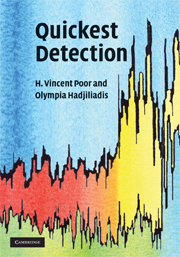5 - Bayesian quickest detection
Published online by Cambridge University Press: 06 July 2010
Summary
Introduction
In Chapter 4, we considered the problem of optimally deciding, with a cost on sampling, between two statistical models for a set of sequentially observed data. Within each of these two models the data are homogeneous; that is, the data obey only one of the two alternative statistical models during the entire period of observation. In most of the remainder of this book, we turn to a generalization of this problem in which it is possible for the statistical behavior of observed data to change from one model to another at some unknown time during the period of observation. The objective of the observer is to detect such a change, if one occurs, as quickly as possible. This objective must be balanced with a desire to minimize false alarms. Such problems are known as quickest detection problems. In this and subsequent chapters, we analyze several useful formulations of this type of problem. Again, our focus is on the development of optimal procedures, although the issue of performance analysis will also be considered to a degree.
A useful framework for quickest detection problems is to consider a sequence Z1, Z2,… of random observations, and to suppose that there is a change point t ≥ 1 (possibly t = ∞) such that, given t, Z1, Z2, …, Zt−1 are drawn from one distribution and Zt, Zt+1, …, are drawn from another distribution.
- Type
- Chapter
- Information
- Quickest Detection , pp. 102 - 129Publisher: Cambridge University PressPrint publication year: 2008
- 1
- Cited by



